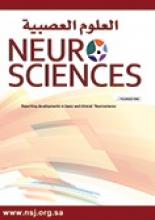Research ArticleOriginal Article
Open Access
Clinical characteristics of antidepressant use and related manic switch in bipolar disorder
Tonguc D. Berkol, Yasin H. Balcioglu, Simge S. Kirlioglu, Zengibar Ozarslan, Serkan Islam and Ilker Ozyildirim
Neurosciences Journal January 2019, 24 (1) 45-52; DOI: https://doi.org/10.17712/nsj.2019.1.20180008
Tonguc D. Berkol
From the Department of Psychiatry (Berkol, Balcioglu, Kirlioglu), Bakirkoy Prof. Mazhar Osman Training and Research Hospital for Psychiatry, Neurology, and Neurosurgery, from the Psychiatry Unit (Ozarslan), Arnavutkoy State Hospital, from the Department of Psychiatry (Islam), Haseki Training and Research Hospital, and from the Department of Psychiatry (Ozyildirim), Oteki Psychoterapy Center, Istanbul, Turkey
MDYasin H. Balcioglu
From the Department of Psychiatry (Berkol, Balcioglu, Kirlioglu), Bakirkoy Prof. Mazhar Osman Training and Research Hospital for Psychiatry, Neurology, and Neurosurgery, from the Psychiatry Unit (Ozarslan), Arnavutkoy State Hospital, from the Department of Psychiatry (Islam), Haseki Training and Research Hospital, and from the Department of Psychiatry (Ozyildirim), Oteki Psychoterapy Center, Istanbul, Turkey
MDSimge S. Kirlioglu
From the Department of Psychiatry (Berkol, Balcioglu, Kirlioglu), Bakirkoy Prof. Mazhar Osman Training and Research Hospital for Psychiatry, Neurology, and Neurosurgery, from the Psychiatry Unit (Ozarslan), Arnavutkoy State Hospital, from the Department of Psychiatry (Islam), Haseki Training and Research Hospital, and from the Department of Psychiatry (Ozyildirim), Oteki Psychoterapy Center, Istanbul, Turkey
MDZengibar Ozarslan
From the Department of Psychiatry (Berkol, Balcioglu, Kirlioglu), Bakirkoy Prof. Mazhar Osman Training and Research Hospital for Psychiatry, Neurology, and Neurosurgery, from the Psychiatry Unit (Ozarslan), Arnavutkoy State Hospital, from the Department of Psychiatry (Islam), Haseki Training and Research Hospital, and from the Department of Psychiatry (Ozyildirim), Oteki Psychoterapy Center, Istanbul, Turkey
MDSerkan Islam
From the Department of Psychiatry (Berkol, Balcioglu, Kirlioglu), Bakirkoy Prof. Mazhar Osman Training and Research Hospital for Psychiatry, Neurology, and Neurosurgery, from the Psychiatry Unit (Ozarslan), Arnavutkoy State Hospital, from the Department of Psychiatry (Islam), Haseki Training and Research Hospital, and from the Department of Psychiatry (Ozyildirim), Oteki Psychoterapy Center, Istanbul, Turkey
MDIlker Ozyildirim
From the Department of Psychiatry (Berkol, Balcioglu, Kirlioglu), Bakirkoy Prof. Mazhar Osman Training and Research Hospital for Psychiatry, Neurology, and Neurosurgery, from the Psychiatry Unit (Ozarslan), Arnavutkoy State Hospital, from the Department of Psychiatry (Islam), Haseki Training and Research Hospital, and from the Department of Psychiatry (Ozyildirim), Oteki Psychoterapy Center, Istanbul, Turkey
MD
References
- ↵
- Miller S,
- Dell'Osso B,
- Ketter TA
- ↵
- Strakowski SM
- ↵
- Pacchiarotti I,
- Bond DJ,
- Baldessarini RJ,
- Nolen WA,
- Grunze H,
- Licht RW,
- et al.
- ↵
- Yatham LN,
- Kennedy SH,
- Parikh SV,
- Schaffer A,
- Beaulieu S,
- Alda M,
- et al.
- ↵
- Geddes JR,
- Miklowitz DJ
- ↵
- Liu B,
- Zhang Y,
- Fang H,
- Liu J,
- Liu T,
- Li L
- ↵
- Baldessarini RJ,
- Leahy L,
- Arcona S,
- Gause D,
- Zhang W,
- Hennen J
- ↵
- Grande I,
- de Arce R,
- Jiménez-Arriero MÁ,
- Lorenzo FG,
- Valverde JI,
- Balanzá-Martínez V,
- et al.
- ↵
- American of Psychiatric Association
- ↵
- Hayasaka Y,
- Purgato M,
- Magni LR,
- Ogawa Y,
- Takeshima N,
- Cipriani A,
- et al.
- ↵
- Sachs GS
- ↵
- Vieta E,
- Nieto E,
- Autet A,
- Rosa AR,
- Goikolea JM,
- Cruz N,
- et al.
- ↵
- Grunze H,
- Vieta E,
- Goodwin GM,
- Bowden C,
- Licht RW,
- Möller HJ,
- et al.
- ↵
- Truman CJ,
- Goldberg JF,
- Ghaemi SN,
- Baldassano CF,
- Wisniewski SR,
- Dennehy EB,
- et al.
- ↵
- Ghaemi SN,
- Hsu DJ,
- Soldani F,
- Goodwin FK
- ↵
- Amsterdam JD,
- Lorenzo-Luaces L,
- Soeller I,
- Li SQ,
- Mao JJ,
- DeRubeis RJ
- ↵
- Vöhringer PA,
- Ostacher MJ,
- El-Mallakh RS,
- Holtzman NS,
- Thommi SB,
- Whitham EA,
- et al.
- ↵
- Tohen M,
- Vieta E,
- Calabrese J,
- Ketter TA,
- Sachs G,
- Bowden C,
- et al.
- ↵
- Viktorin A,
- Lichtenstein P,
- Thase ME,
- Larsson H,
- Lundholm C,
- Magnusson PK,
- et al.
- ↵
- Bottlender R,
- Rudolf D,
- Strauss A,
- Möller HJ
- ↵
- Mundo E,
- Cattaneo E,
- Russo M,
- Altamura AC
- ↵
- Berkol TD,
- Balcioglu YH,
- Aytac HM,
- Kirlioglu SS,
- Islam S,
- Ozyildirim I
- ↵
- Berkol TD,
- Kirlioglu SS,
- Balcioglu YH,
- Ustun N,
- Islam S,
- Ozyildirim I
- ↵
- Blanco C,
- Laje G,
- Olfson M,
- Marcus SC,
- Pincus HA
- ↵
- Bowden CL,
- Gitlin MJ,
- Keck PE,
- Suppes T
- ↵
- Joffe RT,
- MacQueen GM,
- Marriott M,
- Young LT
- ↵
- Wada K,
- Sasaki T,
- Jitsuiki H,
- Yoshimura Y,
- Erabi H,
- Hada Y,
- et al.
- ↵
- Ghaemi SN,
- Hsu DJ,
- Thase ME,
- Wisniewski SR,
- Nierenberg AA,
- Miyahara S,
- et al.
- ↵
- Visser HM,
- Van Der Mast RC
- ↵
- Leverich GS,
- Altshuler LL,
- Frye MA,
- Suppes T,
- McElroy SL,
- Keck PE Jr.,
- et al.
- ↵
- Henry C,
- Sorbara F,
- Lacoste J,
- Gindre C,
- Leboyer M
In this issue
Clinical characteristics of antidepressant use and related manic switch in bipolar disorder
Tonguc D. Berkol, Yasin H. Balcioglu, Simge S. Kirlioglu, Zengibar Ozarslan, Serkan Islam, Ilker Ozyildirim
Neurosciences Journal Jan 2019, 24 (1) 45-52; DOI: 10.17712/nsj.2019.1.20180008
Jump to section
Related Articles
- No related articles found.
Cited By...
- No citing articles found.





